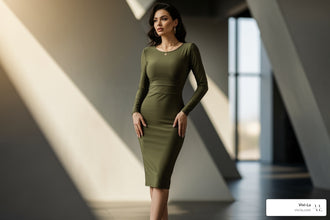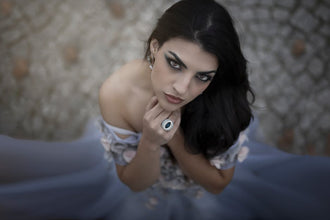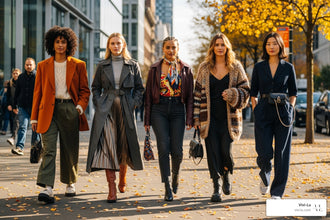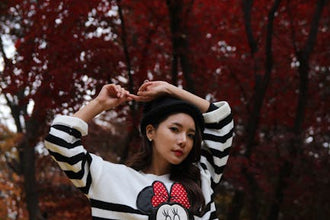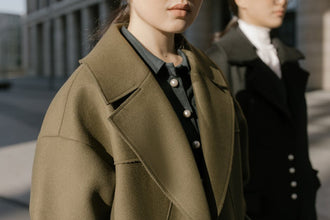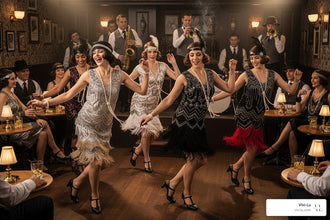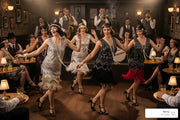
A Decade of Rebellion and Redefined Style
Roaring 20s women's fashion marked one of the most dramatic style revolutions in history, changing women from corseted Victorian figures into liberated, modern beings who danced the Charleston in knee-length dresses.
Key Elements of 1920s Women's Fashion:
- Drop-waist dresses with straight, boyish silhouettes
- Knee-length hemlines (a shocking change from ankle-length)
- Beaded and sequined evening wear for Jazz Age parties
- Bob haircuts and finger waves
- Cloche hats and T-strap heels
- Long pearl necklaces and Art Deco jewelry
- Comfortable daywear replacing restrictive corsets
The decade following World War I brought unprecedented change. As one fashion historian noted, "WWI left women desiring a simple, comfortable lifestyle and a fashion style that reflected the new modern age, where young women outnumbered the older Edwardian generation." The 19th Amendment granted women the right to vote in 1920, while Prohibition sparked speakeasy culture and wild parties that demanded clothes built for dancing.
This wasn't just about shorter skirts - it was a complete rejection of everything that came before. Women acceptd the "La Garçonne" look, flattening their chests and hips to achieve a tubular silhouette that would have horrified their mothers. Fashion became a symbol of liberation, rebellion, and the exciting possibilities of modern life.
I'm Marlena Mika, and through my work with European fashion at Vivi Lu, I've studied how the timeless elegance of roaring 20s women's fashion continues to influence today's trends. The 1920s taught us that true style comes from comfort, confidence, and the courage to break the rules.
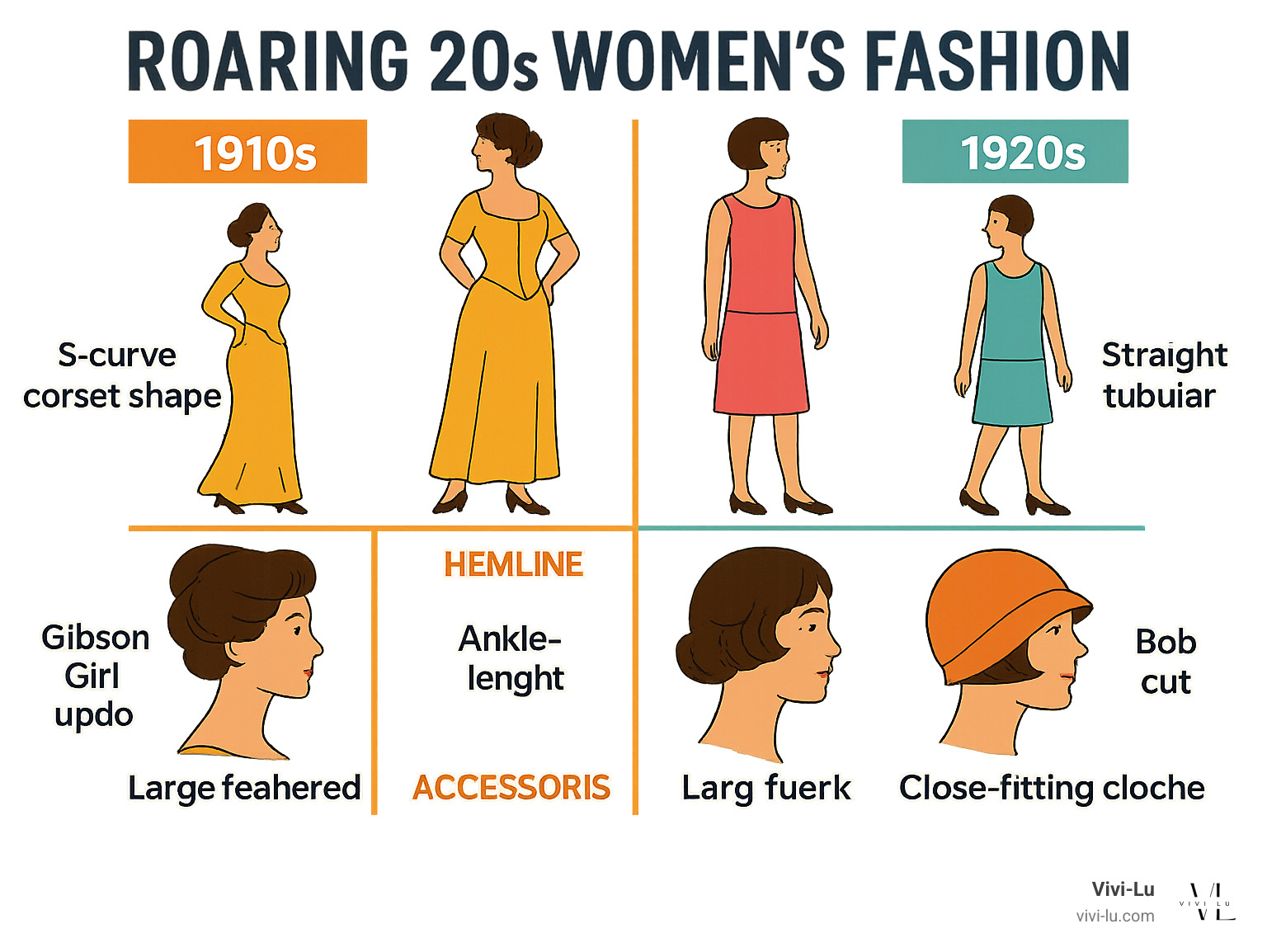
The Social Revolution: How a New Era Forged a New Woman
Roaring 20s women's fashion wasn't just about shorter hemlines; it was the visual soundtrack to a social revolution. The changes in clothing mirrored a profound shift in how society viewed women and how women viewed themselves.
The "New Woman" Emerges
After World War I, women who had worked in factories and driven ambulances were unwilling to return to pre-war norms. They had tasted independence, and their newfound confidence showed in their clothing. Restrictive corsets were replaced by comfortable bandeau bras and loose girdles that helped create the fashionable boyish silhouette.
With the 19th Amendment in 1920, women's suffrage became a reality. Women were voting, working in offices, driving cars, and playing sports. Their clothes had to adapt to their increasingly public lives.
The rejection of Victorian norms was absolute. A simple haircut could be seen as an act of rebellion, making fashion a powerful symbol of women's liberation. Economic prosperity in America also made ready-to-wear clothing more accessible, allowing women to experiment with new styles. For those interested in the politics of this era's fashion, there's fascinating scientific research on the politics of women's fashion in 1920s France.
The Influence of the Jazz Age and Prohibition
Nothing captures the spirit of roaring 20s women's fashion like women dancing the Charleston in a smoky speakeasy, their beaded dresses catching the light.
Jazz music, born in African American communities, inspired energetic dances like the Charleston and the Shimmy, which demanded clothes that allowed for movement.
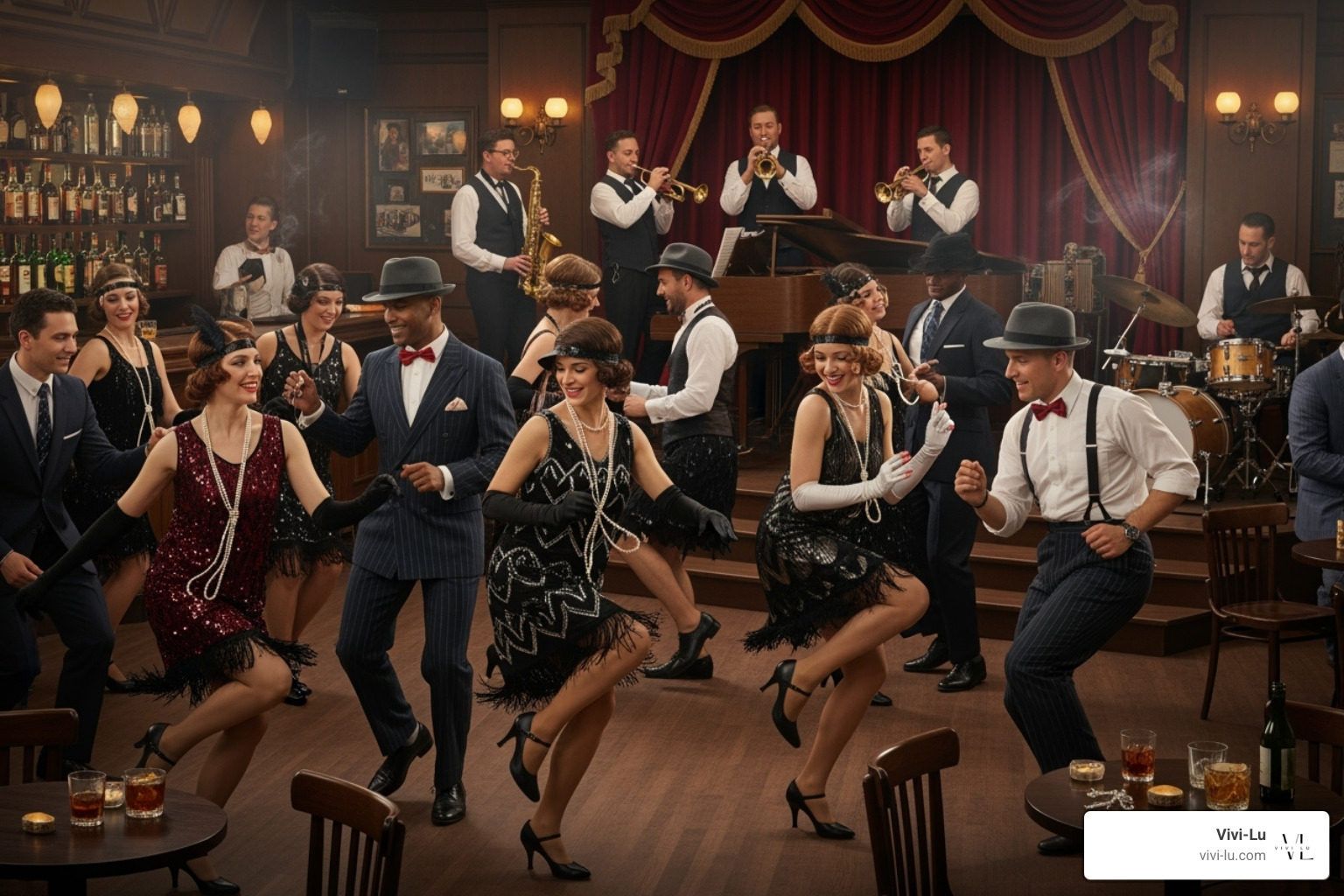
Prohibition inadvertently fueled this new culture. Speakeasy culture flourished, leading to glamorous parties where women needed dresses that could handle a night of dancing. This led to the popularity of fringe that moved with every step and sequins that sparkled in the dim light.
Cocktail dresses became a staple for these new social events. These weren't just clothes; they were statements. Every beaded dress and dropped waist proved that youth culture was taking over. The flamboyant style of the era was about looking free, and women wore their liberation as their most beautiful accessory.
Defining the Decade: Iconic Garments and Silhouettes
When we think of roaring 20s women's fashion, we're witnessing one of history's most dramatic style changes—from structured Victorian silhouettes to the free-flowing looks that defined a generation.
The Flapper Dress: The Heart of Roaring 20s Women's Fashion
The flapper dress was a statement of independence. Its defining feature was the dropped waistline, sitting at the hips to create the signature straight, boyish silhouette that scandalized the older generation.
Contrary to modern depictions, authentic flapper dresses often featured knee-length hemlines or longer. The magic was in the details. Beading and sequins, often in intricate Art Deco patterns, transformed dresses into works of art that caught the light. Fringe was strategically placed to create mesmerizing motion during dances like the Charleston. Sleeveless designs and delicate straps revealed more skin than was previously acceptable.
This look was part of the La Garçonne aesthetic—the boyish style that deliberately flattened curves to create a tubular shape. It was fashion as rebellion.
Beyond the Beads: Daywear, Sportswear, and Outerwear
While flapper dresses ruled the dance floors, roaring 20s women's fashion also had to work for real life. Women needed clothes for their new, active lifestyles.
| Occasion | Fabric | Silhouette | Embellishments |
|---|---|---|---|
| Evening Dress | Silk, satin, velvet, chiffon | Loose, dropped waist | Heavy beading, sequins, fringe, embroidery, rhinestones |
| Day Dress | Cotton, wool, rayon, crepe | Loose, dropped waist | Simple embroidery, piping, rick rack, contrasting collars |
For everyday wear, comfort was key. Housedresses in cheerful cotton prints, checks, and plaids made chores more bearable, often featuring practical details like oversized collars and patch pockets.
Afternoon tea dresses were more refined, crafted from silk or rayon and often paired with matching jackets for social calls. The decade also acceptd separates, with pleated skirts paired beautifully with middy blouses (sailor-inspired tops).
Sports also changed fashion. Tennis dresses became essential as women acceptd athletic activities with enthusiasm.
When it came to outerwear, cocoon coats provided comfort and style with their rounded shape. Fur stoles added glamour to evening looks, while lighter jackets and capes offered versatility.
The 1920s proved that fashion could be both beautiful and practical—a lesson that still resonates today.
The Art of the Accessory: Finishing Touches that Made the Look
The magic of roaring 20s women's fashion wasn't just in the dresses—it was in the details that completed the look. Every accessory told a story of rebellion, sophistication, and self-expression.
Head to Toe: Cloche Hats and T-Strap Heels
In the 1920s, the quintessential headwear was the cloche hat. This bell-shaped hat fit snugly over the new bob haircuts, creating an air of mystery. Cloches were made from felt, straw, or silk and might be adorned with a simple ribbon or elaborate embroidery. For evening, women swapped cloches for dramatic feathered headbands or jeweled Juliet caps.
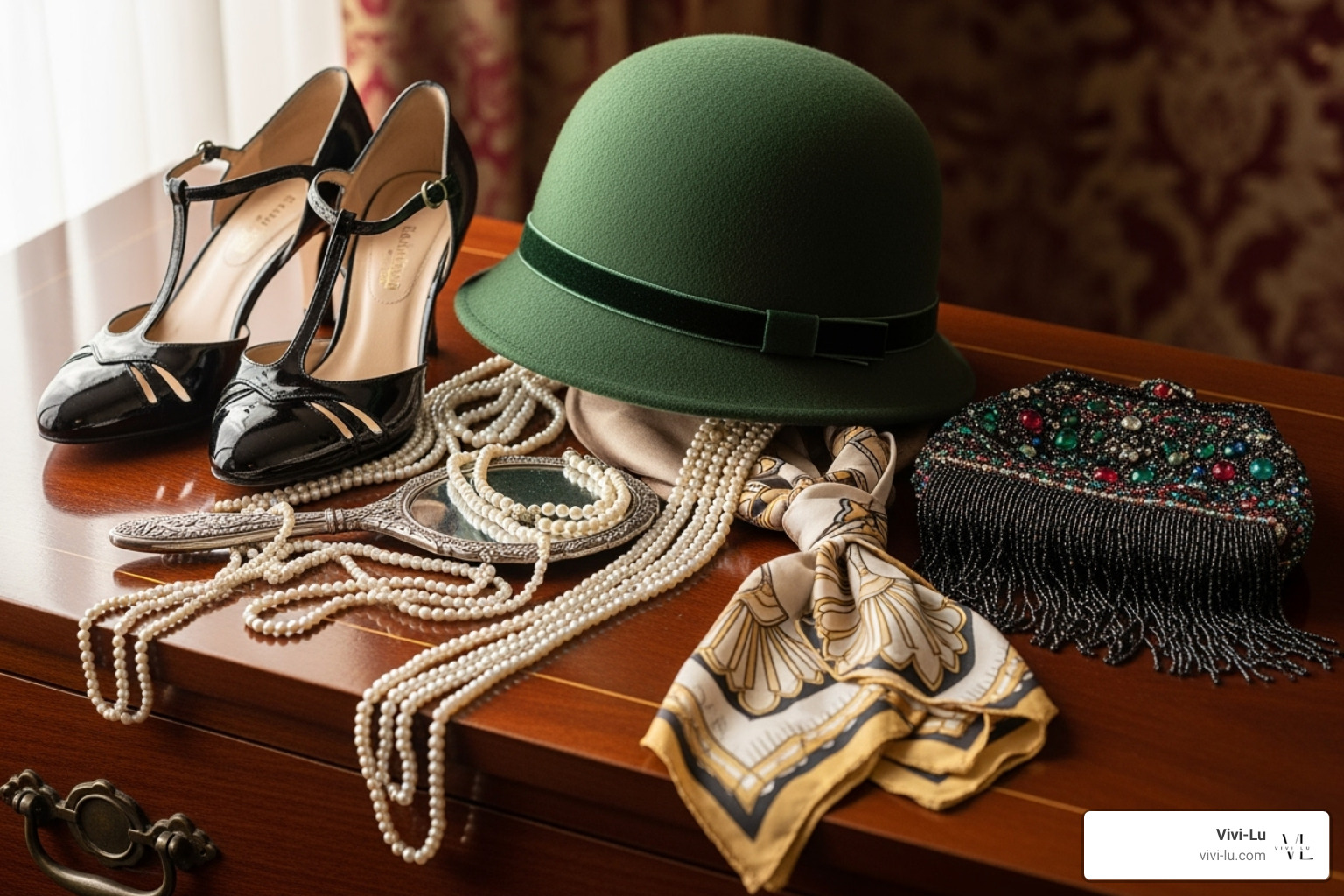
Rising hemlines meant shoes finally got their moment. T-strap heels were the footwear of choice, offering style and stability for dancing. Mary Janes were a sweeter alternative, while sturdy Oxford shoes with low heels were perfect for daywear. Rayon stockings in nude or soft pastels replaced heavy hosiery, creating a sleek leg line that complemented shorter skirts.
Jewels, Makeup, and Hair
The bob haircut was the ultimate symbol of the modern woman. This style, with variations to suit every personality, swept away the elaborate updos of the past. It was often styled with sculpted finger waves. The most daring chose the Eton crop, an extremely short, boyish cut.
Makeup became bolder and more visible. The signature look featured Cupid's bow lips in deep reds and heavy eye makeup with dark kohl eyeliner for a sultry, smoky gaze.
Jewelry acceptd Art Deco design. Long pearl necklaces, often layered and knotted, were the ultimate accessory. Art Deco jewelry included bold bracelets and long, dangling earrings.
A small beaded handbag, large enough for a compact and coins, was essential. For a touch of rebellious glamour, some women used neat cigarette holders.
Essential 1920s Accessories:
- Cloche hats or feathered evening headbands
- Long pearl necklaces (layered and knotted)
- Art Deco jewelry with geometric designs
- Small beaded or mesh handbags
- T-strap heels or Mary Jane shoes
- Sheer rayon stockings
- Long gloves (wrist-length for day, opera-length for evening)
- Feather fans or boas for special occasions
- Stylish compacts and cigarette accessories
Icons and Influences: The Trendsetters of the Twenties
The looks of roaring 20s women's fashion didn't emerge by chance. They were championed by visionary designers and glamorous celebrities who saw fashion as a statement of freedom and modernity.
Coco Chanel's Impact on Roaring 20s Women's Fashion
Gabrielle "Coco" Chanel didn't just design clothes; she rewrote the rules of womenswear. Her philosophy was simple: women deserved comfort without sacrificing elegance.
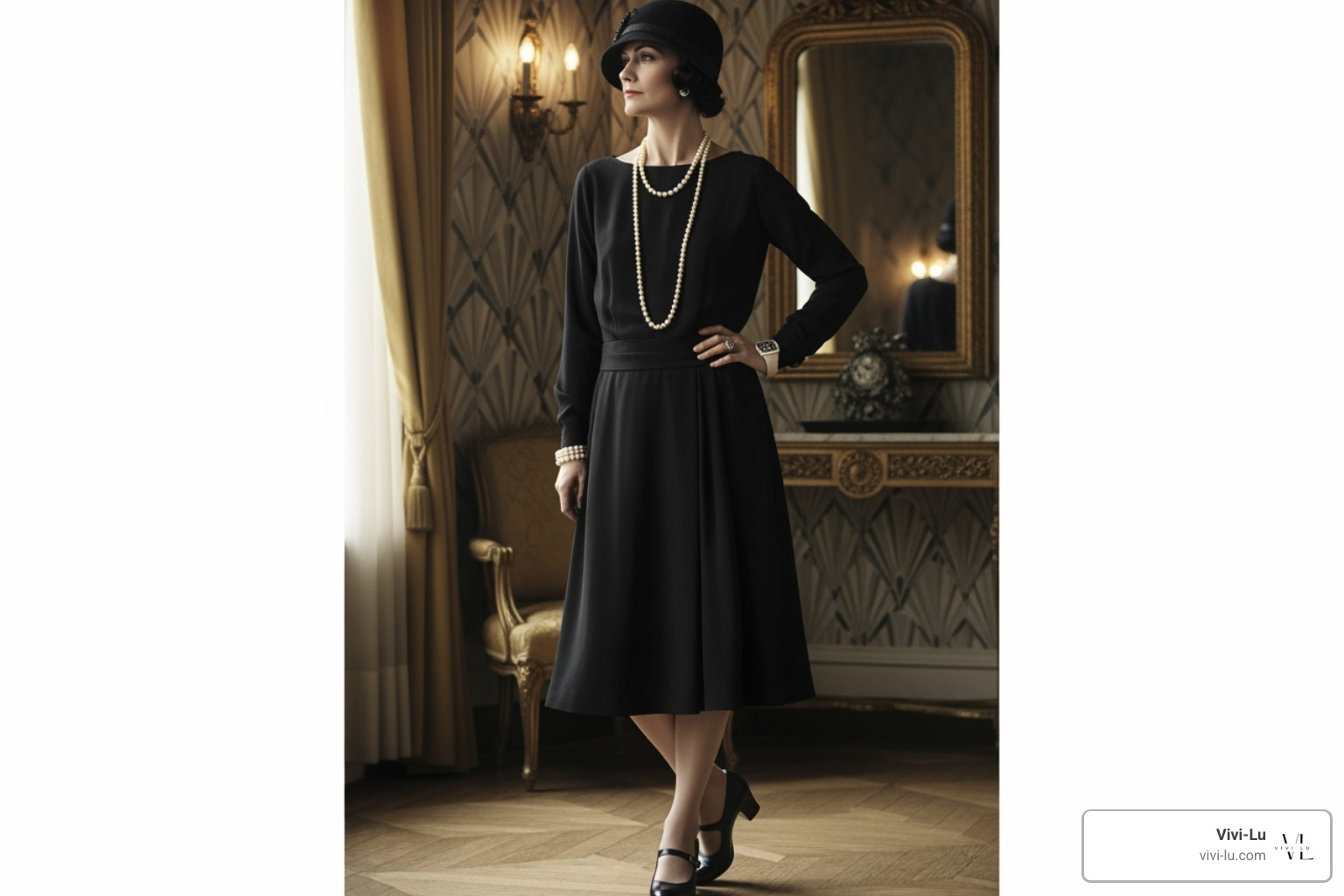
Her use of jersey fabric, previously reserved for men's underwear, allowed women to move in comfort and style. Perhaps her most lasting contribution was the Little Black Dress (1926). Vogue called it a "Ford," predicting it would become as universal as the Model T car. Before Chanel, black was for mourning; she made it the epitome of chic.
Chanel also championed women's trousers and launched her iconic fragrance, Chanel No. 5, in 1921. By the decade's end, her multi-million dollar empire proved women were hungry for her vision of liberated style.
Designers and Celebrities Who Defined the Era
Chanel wasn't alone. Other talented designers and celebrities also helped shape the decade's look.
Madeleine Vionnet earned the title "Queen of the Bias Cut" for her innovative technique of cutting fabric on the diagonal, creating dresses that flowed like liquid and allowed for complete freedom of movement.
Jean Patou understood the modern woman's need for activewear, designing sporty wool jersey ensembles with clean, athletic lines.
The bold Elsa Schiaparelli brought surrealist art to fashion, and her rivalry with Chanel pushed both to greater creative heights.
On the celebrity front, Louise Brooks became a style icon with her razor-sharp bob haircut. Her influential geometric hairstyle had women across America demanding "the Louise Brooks."
Zelda Fitzgerald, wife of author F. Scott Fitzgerald, embodied the wild, carefree spirit of the Jazz Age with her fearless fashion choices.
Clara Bow, the original "It" Girl, brought flapper style to the silver screen. Her expressive look and infectious energy inspired countless young women.
These trailblazers transformed fashion from a set of rigid rules into a playground of self-expression, creating the foundation for modern style as we know it today.
Recreating the Look: Your Guide to Modern Roaring 20s Women's Fashion
The magic of roaring 20s women's fashion hasn't faded one bit! Whether you're planning for a themed party, a Gatsby-inspired event, or just want to add some Jazz Age sparkle to your wardrobe, capturing that iconic 1920s spirit is easier than you might think.
How to Style a 1920s Outfit
Creating an authentic 1920s look starts with understanding what made those original pieces so special. The secret isn't just throwing on any beaded dress - it's about getting the proportions and details just right.
Choosing a dress is your foundation, and the drop-waist silhouette is absolutely non-negotiable. This distinctive style should sit loosely on your body, creating that signature straight, column-like shape that defined the era. The dress should skim rather than cling, giving you that effortless, boyish silhouette that scandalized the older generation back then.
Here's something that might surprise you: while modern costume versions often feature ultra-short hemlines, authentic 1920s dresses were typically knee-length or even longer, especially for evening wear. The real drama came from the movement and embellishments, not from showing lots of leg.
Accessorizing is key - and honestly, this is where the real fun begins! A simple drop-waist dress can be completely transformed with the right finishing touches. Think long pearl necklaces that you can knot or layer, a beaded headband with feathers, and those iconic T-strap shoes that were perfect for dancing the Charleston.
Don't forget about modern interpretations either. You don't need to look like you're wearing a costume to capture that 1920s elegance. Many contemporary pieces draw inspiration from the era, incorporating elements like fringe details, Art Deco beading, or that distinctive dropped waistline into wearable modern designs. These pieces are perfect for special occasions where you want that timeless glamour without looking like you stepped out of a time machine.
For even more detailed guidance and inspiration, check out more styling tips on our blog!
Finding Your Perfect 1920s-Inspired Pieces
Shopping for roaring 20s women's fashion should feel like a treasure hunt, and knowing what to look for makes all the difference. The key is understanding which elements are essential versus which ones are just nice-to-have extras.
Focus on silhouette above everything else. That straight, column-like shape with the dropped waist is what instantly signals "1920s" to anyone who sees it. Without this fundamental element, all the beading and fringe in the world won't give you that authentic feel.
Look for beading and Art Deco patterns when you want to add that signature Jazz Age glamour. Sequins catch the light beautifully, while intricate geometric designs showcase that distinctive Art Deco aesthetic. Fringe isn't just decorative - it was specifically chosen because it moved so beautifully when dancing.
The fabric matters too, especially if you're shopping for evening wear. Silks, satins, velvets, and chiffons were the go-to choices for those glamorous speakeasy parties, while cotton, wool, and rayon worked perfectly for everyday 1920s style.
Sometimes the perfect modern dress paired with authentic-style accessories can capture that 1920s vibe better than a full costume piece. A good cloche hat, long pearl necklace, and T-strap shoes can work magic on a simple contemporary dress.
When you're shopping, keep an eye out for drop-waist designs with loose, straight fits, quality fabrics like silk or chiffon for evening pieces, beading, sequins, fringe, or Art Deco embroidery, knee-length or longer hemlines for authenticity, and classic accessories like T-strap shoes or beaded headbands.
At Vivi-Lu, we understand that roaring 20s women's fashion represents more than just clothing - it's about capturing that spirit of freedom and elegance that defined an entire generation. We curate collections that blend historical inspiration with modern wearability, so you can experience that Jazz Age glamour in your everyday life. With our fast & free shipping over $200, quick 1-4 day order processing, and hassle-free 14-day return policy, finding your perfect 1920s-inspired piece is as easy as it should be.
Frequently Asked Questions about 1920s Women's Fashion
Let's clear up some common confusion about roaring 20s women's fashion! These are the questions we hear most often from our customers who are diving into this glamorous era.
What is the difference between a flapper dress and a Great Gatsby dress?
Here's where things get interesting! A flapper dress is actually the umbrella term for any 1920s-style dress with that signature dropped waist and straight, loose silhouette. Think of it as the general uniform of the rebellious young women of the era - flappers could wear simple cotton day versions for running errands or more elaborate styles for evening out.
A "Great Gatsby dress" is really just marketing speak for the most glamorous version of a flapper dress. We're talking about those show-stopping, heavily beaded or sequined numbers that would be perfect for one of Jay Gatsby's legendary parties. Every Gatsby dress is technically a flapper dress, but not every flapper dress has that over-the-top, party-ready glamour.
So if you're shopping for a themed party, a "Gatsby dress" will give you maximum sparkle and drama, while a general flapper dress might be more wearable for everyday vintage-inspired looks.
What did women wear in the 1920s besides flapper dresses?
Roaring 20s women's fashion was surprisingly practical and diverse! While flapper dresses get all the attention, real women in the 1920s had busy, active lives that required different outfits.
For everyday wear, women loved simple day dresses made from cotton or rayon. These featured the same dropped waist but were much more understated - think cheerful prints, contrasting collars, or subtle embroidery instead of heavy beading.
Separates were becoming popular too. Women would pair pleated skirts with collared blouses or neat tunic tops. This gave them more flexibility in their wardrobes and was perfect for the office or casual social calls.
The 1920s also saw the birth of real sportswear for women. Tennis dresses, practical bathing suits (still quite modest!), and even knickerbockers for outdoor activities showed how women's lives were expanding beyond the parlor.
For more formal daytime occasions, afternoon dresses in silk or crepe struck the perfect balance - more refined than everyday wear but not as elaborate as evening gowns.
What hairstyle was most popular in the 1920s?
The bob haircut absolutely ruled the decade! This wasn't just a hairstyle - it was a statement of independence that shocked parents everywhere.
Women chopped their long locks to chin or ear length, creating a sleek, modern look that perfectly complemented those close-fitting cloche hats. The most popular way to style a bob was with finger waves - those gorgeous, sculpted waves that lay close to the head. Some women preferred the Marcel wave, which used heated irons to create more defined waves.
The most daring women went for the Eton crop - an extremely short, almost boyish cut that was considered quite scandalous. Even women who weren't ready to actually cut their hair would pin and style longer locks to fake the fashionable bobbed look.
This short hair revolution was so significant that it perfectly symbolized the era's break from tradition. After centuries of elaborate updos, women were literally and figuratively letting their hair down!
Conclusion: The Enduring Legacy of 1920s Style
When we look back at the Jazz Age, it's clear that roaring 20s women's fashion was far more than a fleeting trend - it was a complete revolution that changed how women dressed forever. This wasn't just about shorter hemlines or dropped waists; it was about women claiming their right to comfort, movement, and self-expression through what they wore.
The impact of this decade still echoes through fashion today. Modern designers continue to draw inspiration from the clean lines of the drop-waist silhouette, the glamour of Art Deco beading, and the rebellious spirit that made women trade their corsets for freedom. Walk into any vintage-inspired boutique or browse through contemporary evening wear collections, and you'll spot those unmistakable 1920s influences - the straight, column-like dresses, the geometric patterns, and that sense of effortless elegance that defined the era.
What makes roaring 20s women's fashion truly timeless is its underlying philosophy. The women of the 1920s taught us that style should never come at the expense of comfort or confidence. They showed us that fashion could be both practical and beautiful, rebellious and neat. Whether it's Coco Chanel's Little Black Dress that remains a wardrobe staple nearly a century later, or the way we still love long pearl necklaces and T-strap shoes for special occasions, these pieces prove that authentic style transcends decades.
The spirit of the flapper - that bold, unapologetic accept of modernity - continues to inspire women who want to make their own fashion rules. Every time someone chooses comfort over convention, or adds a touch of sparkle to brighten their day, they're channeling that same energy that transformed fashion in the 1920s.
At Vivi-Lu, we understand that timeless elegance never goes out of style. Our curated collections capture the essence of that iconic decade while offering the quality and convenience modern women deserve. With our fast & free shipping over $200, quick 1-4 day order processing, and hassle-free 14-day return policy, finding your perfect piece of 1920s-inspired glamour has never been easier.



